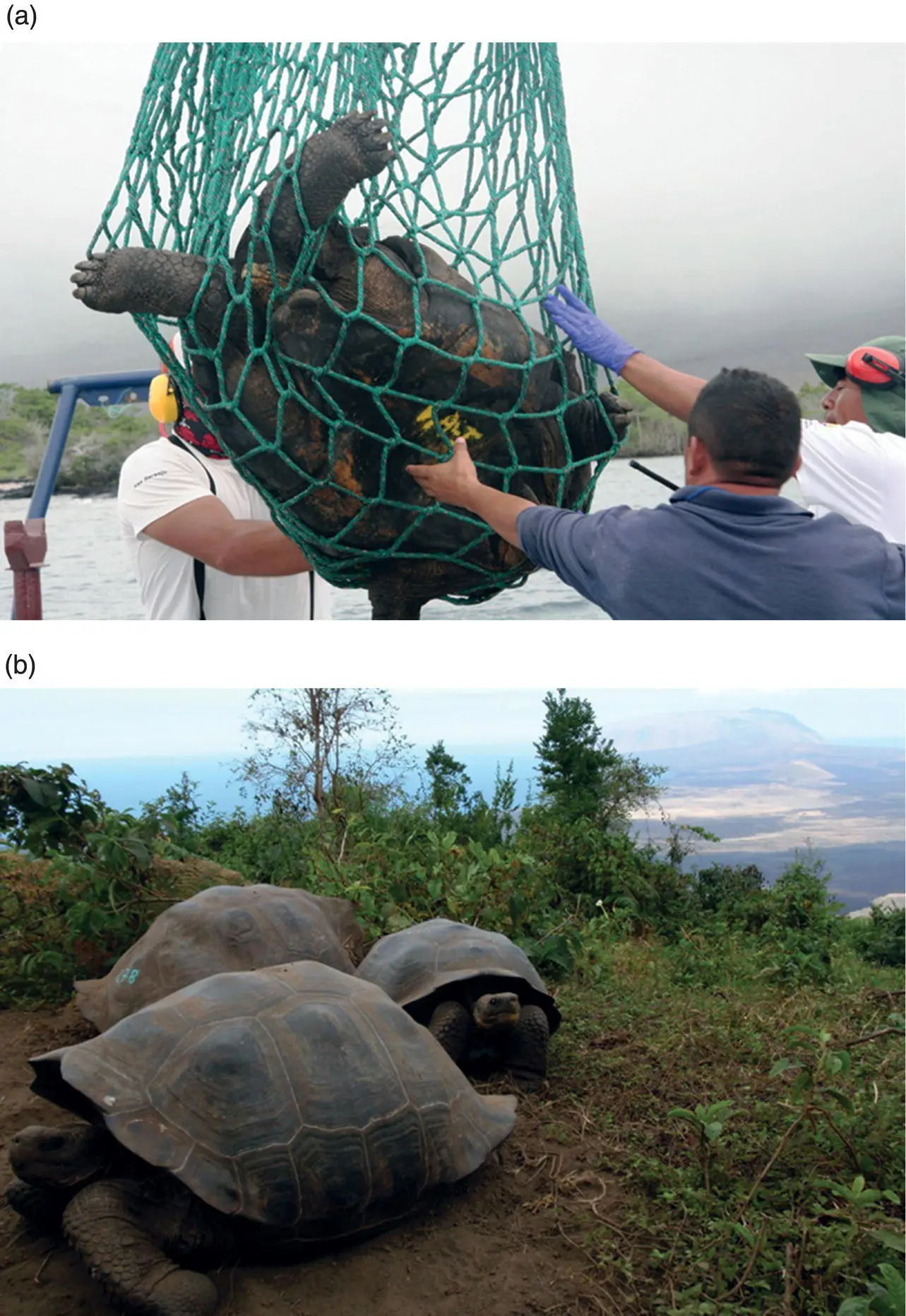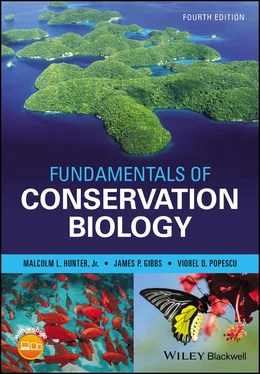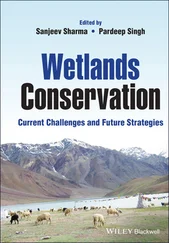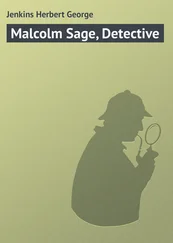Disease is a primary threat to many species but it is often difficult to diagnose based solely on external symptoms. Screening for the DNA of possible disease agents has revolutionized diagnosis and treatment, for example for many amphibians (e.g. Collins 2013) and Tasmanian devils (Morris et al. 2015).
Environmental DNA, or eDNA, is DNA collected from environmental samples such as soil, water, or even air rather than directly sampled from an individual organism. Such eDNA usually originates from shed skin cells that accumulate in an organism’s environment via feces, mucus, gametes, shed skin, carcasses, and hair. Sometimes, eDNA can be extracted from the meals found in guts of blood‐sucking or predator arthropods. Samples of the environment where organisms of interest might live can be analyzed with DNA sequencing methods, known as metagenomics, for rapid measurement and monitoring of species richness and community composition. eDNA is particularly useful for detecting rare species without having to capture them. The approach may eventually be able to tell us about population size and dynamics and species geographic distribution, but the methods are still under development. A helpful overview on the uses and limitations of eDNA is provided by Cristescu and Hebert (2018).
We now are approaching a new era in which we can provide endangered species with new traits that enable them to deal with the threats they are facing. For example, scientists have transferred two genes from wheat into the American chestnut, conferring upon the chestnut resistance to a fungal blight that nearly eradicated it across the vast range in which it was a dominant species (Powell 2014). Genetic engineering may also generate novel genes that can be introduced into populations of invasive exotic species so that they limit their own numbers, a distinct possibility now for dealing with the scourge of endemic island species everywhere: black rats (Campbell et al. 2015). Genetic engineering falls within the realm of “synthetic biology” and offers extraordinary opportunities to address some seemingly intractable conservation issues (Piaggio et al. 2017) while also posing new ethical quandaries. Some straightforward applications include transplanting genes for resistance to white‐nose syndrome into bats and to chytrid fungus into amphibians, or giving corals that are vulnerable to bleaching carefully selected genes from nearby corals that are more tolerant of heat and acidity. More controversial would be eliminating populations of feral cats and dogs by producing generations that are genetically programmed to be sterile. The same is envisioned for eradicating mosquitoes without pesticides, including in areas where mosquitoes vector diseases that hobble endangered species, as in the case of birds in Hawaii. Perhaps most daunting, intriguing, and controversial of all is the possibility to resurrect extinct species through synthetic biology, grafting fragments of their DNA harvested from museum specimens into similar, extant surrogate species to recreate admixtures that largely appear and function as the original species once did (Shapiro 2017). This is being done using Asian elephants to snip into their genome functional and distinctive genes from extinct mammoths to recreate something resembling the latter to release upon the Siberian tundra to help clear woody vegetation, deepen penetration of freezing temperatures into the permafrost, and help slow the melting of the Arctic (Campbell and Whittle 2017).
CASE STUDY 5.1 Galápagos Giant Tortoises
The Galápagos Archipelago in Ecuador is home to many unusual species, including Darwin’s finches, marine and land iguanas, and, perhaps their most famous inhabitants, giant tortoises. These animals are indeed giants, weighing up to 400 kg. Giant tortoises were found on most continents during the Pleistocene but now persist only on two groups of remote oceanic islands: the Galápagos and the Seychelles. Only in the Galápagos do multiple populations survive, although only some 10 species of the original 15 still survive in the wild. A major reason for their endangerment is that an estimated 200,000 tortoises were taken from wild populations starting in the seventeenth century when buccaneers and whalers collected tortoises as a source of fresh meat.
Although they have been studied for centuries, recent research on Galápagos tortoises based on modern molecular genetic techniques has catapulted our understanding, starting with a 10‐year‐long effort to survey every remaining tortoise population, archiving blood samples and extracting DNA from some 5000 individual tortoises. DNA sequencing in mitochondria as well as microsatellites was undertaken to shed light on relationships among populations and to assist with designing captive breeding programs.
What has been learned? This research revealed a new species of giant tortoise (Poulakakis et al. 2015). On the largest island of Santa Cruz people have long known of a small and nondescript population of tortoises at a remote site named Cerro Fatal. Genetic analyses revealed that the Cerro Fatal tortoises are more different from the other tortoises with which they share the island of Santa Cruz than from tortoises anywhere else in the archipelago. In other words, they likely represent an entirely separate colonization of the island and are worthy of special protection as a distinct species of tortoises. This newly described species is now receiving more attention from management authorities.
One curious pattern emerged; although most individuals in any tortoise population are quite similar genetically, certain individuals stand out as being completely different (Caccone et al. 2002). This is particularly true of a remote volcano on the northern end of Isabela Island near a harbor for sailing ships during the whaling era. Genetic analyses have now determined that this volcano holds many members of the island’s endemic species but also many “aliens” that turn out to be descendants of two extinct tortoise species, one from Pinta Island where they recently went extinct, and one from Floreana Island where they have not been seen since about 1980. They apparently were moved by whalers some 150–200 years ago and abandoned before they were killed. Now, thanks to insights from molecular genetics, we have a new option for rescuing extinct giant tortoise species and “re‐tortoising” their original islands. In fact, this process is now ongoing for Floreana Island ( Fig. 5.14) (Miller et al. 2018).

Figure 5.14 An “alien” giant tortoise (a) recently discovered on a remote volcano on northern Isabela Island in the Galápagos among thousands of endemic tortoises (b). The “alien” is believed to be descended from an extinct species (the Floreana Island tortoise). This individual is being removed from the wild by helicopter to a captive rearing center on another island. This and another 20–30 such hybrid individuals are now being incorporated into the breeding program to generate offspring for restoring tortoises on Floreana Island where tortoises have not been seen for over 150 years, a process closely informed by genetic analysis (Miller et al. 2018).
(James P. Gibbs, author)
Genetic analyses have been particularly important in guiding the captive breeding programs for endangered tortoises. For the Española species, reduced to just 15 individuals before being brought into captivity for safekeeping and producing over 1000 offspring, Milinkovitch et al. (2004) used microsatellite markers in a maternity/paternity assessment of the offspring and found that the genetic contribution of the remaining adults to the offspring pool is very uneven. In other words, modifications of the breeding program are likely warranted. The analysis pointed out specifically which individual adults should be emphasized or de‐emphasized through managed pairings.
Читать дальше













